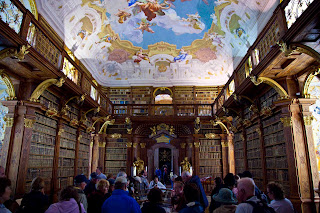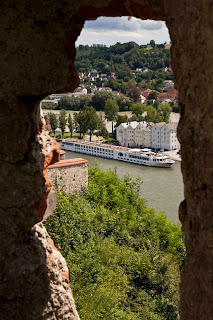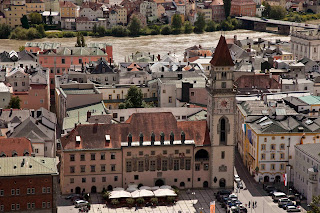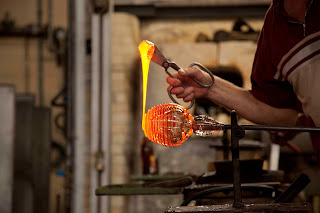









The air itinerary over was long and drawn out with all our connections, but we finally made it to Nürnberg (the actual German for Nuremberg) at 7 last night. We decided to take a cab to the boat rather than being adventurous and try our hand at the train. We were just too bushed. Got to dinner on board the River Countess just a little late and joined two other couples who had been on board for the past week coming from Basel, Switzerland. Over dinner, they caught us up with what we had missed and gave us a few pointers for cruising. Our cabin is two doors down from the dining room which is great when you are completely exhausted. We flopped into bed and were out until the alarm interrupted our beauty sleep at 7 am. Time to start vacation!
This morning we had our choice of seeing the medieval walled city of Nürnberg or to take a special WW II tour of sites associated with the rise of the Nazi party and then the courtroom for the Nürnberg Trials. We opted for the latter, though we wished we could have done both. As we boarded our bus to start the tour, it was obvious to us that this was not going to be our usual active vacation.
Our first stop was the Zeppelin Field where Hitler held massive rallies for the Nazi Party between 1933 and 1938. The grandstand is still standing, though parts like the giant swastikas and eagles were demolished by conquering US troops on April 22, 1945. The city of Nürnberg also demolished sections that they felt were unsafe, but one can still climb to the top and stand on the podium where Hitler ranted to the masses. He was hopefully rolling over in his grave as the Cohens stood in his place. It was a bit unsettling imagining all the footage from newsreels and the History Channel we’ve seen that showed these torchlight rallies with thousands of rabid anti-Semites pledging their lives to Adolph Hitler.
From here we crossed a small man-made lake to see the Documentation Center, a museum dedicated to documenting the rise and fall of the Nazi Party so that the German people would not forget and allow it to happen again. The museum is housed in an enormous building that was never completed by the Nazis. It was to be able to hold 50,000 Nazi Party delegates for a convention to be held once a year (great use of resources). It was designed to be reminiscent of the Coliseum in Rome. The beginning of WWII halted work on the project. It remains as a decaying reminder of the Nazi presence in Nürnberg.
Our final stop was the site of the Nuremberg Trials during 1945 and 1946. On trial were the 21 remaining major Nazi leaders (Hitler, Goebbels, and Himmler all had committed suicide) charged with crimes against humanity. Included in this group were Herman Goering, Rudolf Hess, Martin Borman (in absentia), Albert Speer and others. Of the 21, 3 were aquitted, 14 sentenced to death (Goering committed suicide on the day of his hanging and Borman was never found but presumed dead in the bombing of Berlin) and the remaining 4 receiving sentences from 20yr to life. The courtroom is still used today, though it has reverted to its original size. It had been expanded for the trials to allow for press and spectators.
We were then back on the bus to catch the boat which had left Nürnberg earlier. We re-boarded in Roth, and began a beautiful, relaxing cruise down the Main (pronounced “mine”)-Danube canal, a canal connecting the Main River to the Danube River. The canal brought us up over the continental divide through a series of locks two of which were 82 feet high! The cruise boats are designed to just fit into these locks, and I mean JUST. There was about 18 inches between the side of the boat and the walls of the lock.
There were also several bridges that crossed the canal, most of which were low enough to take off heads if you happened to stand up on the sun deck at the right moment. In fact the bridge of the ship is actually designed to retract with the captain's head just poking out of a sun roof.
Tomorrow we arrive at Regensburg on the Danube. I guess we’ll find out if it’s really blue.






















































